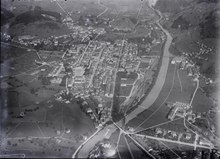Glarus
![]()
This article is about the municipality of Glarus in the canton of the same name, for other meanings of Glarus see Glarus (disambiguation).
The town of Glarus (locally Swiss German Glaris [glɑrɪs], French Glaris, Italian Glarona, Rhaeto-Romanic![]() ) is a political municipality (until 2010 local municipality, now unitary municipality) and the capital of the Swiss canton of Glarus of the same name.
) is a political municipality (until 2010 local municipality, now unitary municipality) and the capital of the Swiss canton of Glarus of the same name.
As part of the Glarus municipal reform, Glarus merged with the municipalities of Ennenda, Netstal and Riedern on 1 January 2011 to form the new political municipality of Glarus.

Coat of arms of the local municipality existing until 31 December 2010
Geography
Glarus lies in the geographical centre of the canton of the same name on the River Linth and at the foot of the approximately 2300 m high Vorderglärnisch. The highest point of the municipality is the 2914 m high Bächistock, which is part of the Glärnisch massif. Neighbouring municipalities are Glarus Nord, GlarusSüd and Muotathal and Innerthal (both Canton Schwyz).
Climate table
| Glarus, 1981-2010 | ||||||||||||||||||||||||||||||||||||||||||||||||
| Climate diagram | ||||||||||||||||||||||||||||||||||||||||||||||||
| ||||||||||||||||||||||||||||||||||||||||||||||||
| Monthly average temperatures and precipitation for Glarus, 1981-2010
Source: | |||||||||||||||||||||||||||||||||||||||||||||||||||||||||||||||||||||||||||||||||||||||||||||||||||||||||||||||||||||||||||||||||||||||||||||||||||||||||||||||||||||||||||||||||||||||||||||||||||||||||||||||||||||||||||||||||||||||||||||||||||||||||||||||||||||||||||

Historical aerial photograph from 1000 m by Walter Mittelholzer from 1923
History
The place Clarona is first mentioned in writing in the 8th century in a life story of the saints Felix and Regula. The name probably goes back to a Latin base form *ad clārōnam "by the bright place", in a figurative sense "forest clearing".
Until the end of the 14th century, large parts of the Glarus land belonged to the landlordship of the Säckingen monastery, until the inhabitants bought themselves off it. In 1387 the first Landsgemeinde took place, an institution that still exists here today and is usually held on the first Sunday in May. Glarus became the main town of the Linth Valley by decision of the Landsgemeinde in 1419, as the only church in the valley stood here for a long time. From 1506 to 1516, the later reformer Ulrich Zwingli was a popular Catholic priest in Glarus. From 1522 to 1555, Valentin Tschudi was the first Protestant pastor, a moderate reformer and mediator between the two confessions. From 1555 to 1570 Fridolin Brunner followed as pastor, who had previously carried out the Reformation in several Glarus villages.
During the Helvetic period (1798-1803) Glarus was the capital of the Canton of Linth.
In 1861, a devastating fire raged through the town, destroying large parts of it. Only a few buildings from the time before the fire remained in the townscape. Reconstruction took place very quickly according to an urban plan based on a rectangular grid. This type of urban planning, known mainly from the United States, was chosen to prevent further conflagrations of this kind.
Search within the encyclopedia